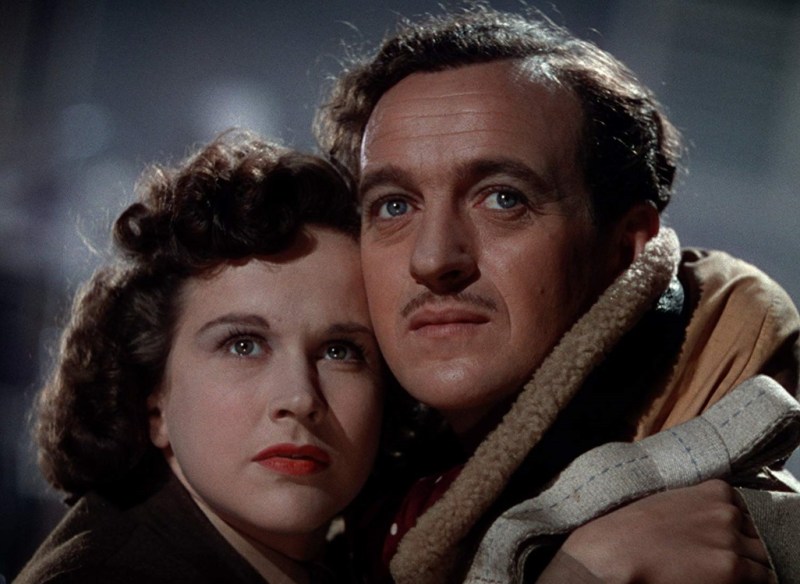Michael Powell and Emeric Pressburger began shooting their film “A Matter of Life and Death” in September 1945. A month earlier, the Japanese government surrendered to the Allies and World War II ended. Yet, the war is an essential part of the movie’s plot. The protagonist of the picture, Peter Carter, is a Royal Air Force pilot. As he returns from a bombing mission in Germany, his plane is badly damaged. He informs June, an American radio operator, of his plight. June is anguished when Peter tells her he has no choice but to jump from the plane without a parachute. Miraculously, however, Peter lands intact. He finds June, and they begin a romance, but then, something strange occurs. While sitting with June in the garden, an effete Frenchman appears and introduces himself as Conductor 71. He claims that he was sent to take Peter off to heaven. While he was supposed to ferry Peter there after he abandoned his plane, he missed him because of the fog. Peter protests, declaring that he should not be held responsible for the conductor’s mistake. Furthermore, he notes that in the extra twenty hours he has had on earth, he has fallen in love. The hosts of heaven agree to hear Peter’s appeal, and they hold a trial to pit the strength of his love against the sheer inevitability of death.
The story’s frank discussion of death would have appealed to an audience who had experienced loss in the war. Yet, the film is less a portrayal of the recent war than a prayer for pluralism and peace.
Powell and Pressburger were not the only filmmakers to confront the trauma of the conflict after its end. The protagonists of William Wyler’s American epic “The Best Years of Our Lives” found that the war had embezzled their best years. Wyler conveyed the stories of characters crippled by the conflict and demonstrated that it was difficult for veterans to readjust to civilian life. In Italy, neorealist filmmakers like Roberto Rossellini and Vittoro de Sica focused on the destruction the war left in its wake. Their films, like “Paisan” and “Bicycle Thieves,” were shot on grainy black-and-white film stock and chronicled the travails of everyday individuals. The heroes of these films were irrevocably impacted by the recent turmoil.
Like Wyler’s heroes, Peter Carter struggles to find his place in the postwar world, and like the individuals in neorealist dramas, his dilemma develops out of the war. Yet, in telling his story, Powell and Pressburger do not dwell on disability, destruction or death. Peter is only temporarily incapacitated. Once these paradisiacal phantoms stop perplexing him, he will be able to fully enjoy life. There are no records of ruins in this film. Alfred Junge’s production design is impressive and immaculate. Places on earth seem lively and luxurious. Celestial spaces are markedly modern and minimalist.
Whereas Wyler and the neorealist filmmakers depicted death in a graphic manner, there is nothing particularly cruel or colorful in Powell and Pressburger’s conception of death. They rendered heaven in black-and-white, but not the inelegant monochrome of newsreels. Instead, the hue of the heavens recalls a timeless photograph. This is an unvarnished and unchanging world.
By contrast, Powell and Pressburger portrayed the realm of the living in stunning Technicolor. Cinematographer Jack Cardiff used bright tones to bring out the vivaciousness of this world. Thus, when Peter lands on the beach after his fall, the beach appears as if it is an Impressionist painting by Mary Cassatt or Pierre Auguste Renoir come to life.
Powell and Pressburger decided to switch between black-and-white and color after watching “The Wizard of Oz.” In that film, Dorothy’s drab Kansas is illustrated in sepia, while the otherworldly land of Oz appears in luminous color. By rendering the fantastical domain of heaven in black-and-white and quotidian life in color, Powell and Pressburger suggest that life after the war is a kind of Oz. Just as Dorothy experiences adventure in Oz, life will continue to be dynamic in peacetime. Yet, just as Dorothy’s Auntie Em remains in Kansas, heaven is populated with kindly figures. Powell and Pressburger’s amicable vision of the afterlife would have comforted viewers who now had loved ones there because of the war.
Interestingly, both domains are progressive places. A woman holds the highest office in heaven, while June is a surprisingly strong character. She endeavors to keep Peter alive through the sheer force of her will. The effeminate French dandy is the emissary of heaven and carves a niche in both spheres. The jury that hears Peter’s case is extraordinarily diverse. It is composed of Americans from various eras, including a first-generation Japanese-American, an African-American soldier who fought in World War I, and a Russian immigrant. Despite their differences, these individuals are able to concur on a verdict.
In some sense, the jury is continuing the work of World War II. A plethora of disparate groups united to preserve human rights and put an end to Nazi carnage. By acknowledging the contributions that all kinds of people made to the war effort, Powell and Pressburger pray that the world after the war will be pluralistic and free of prejudice. Perhaps Powell, Pressburger and Peter Carter would be disillusioned with the world we have created seventy years later. Yet, perhaps that’s why “A Matter of Life and Death” continues to resonate. In our troubled times, we need the film to remind us how lovely life can be.
Contact Amir Abou-Jaoude at amir2 ‘at’ stanford.edu.
